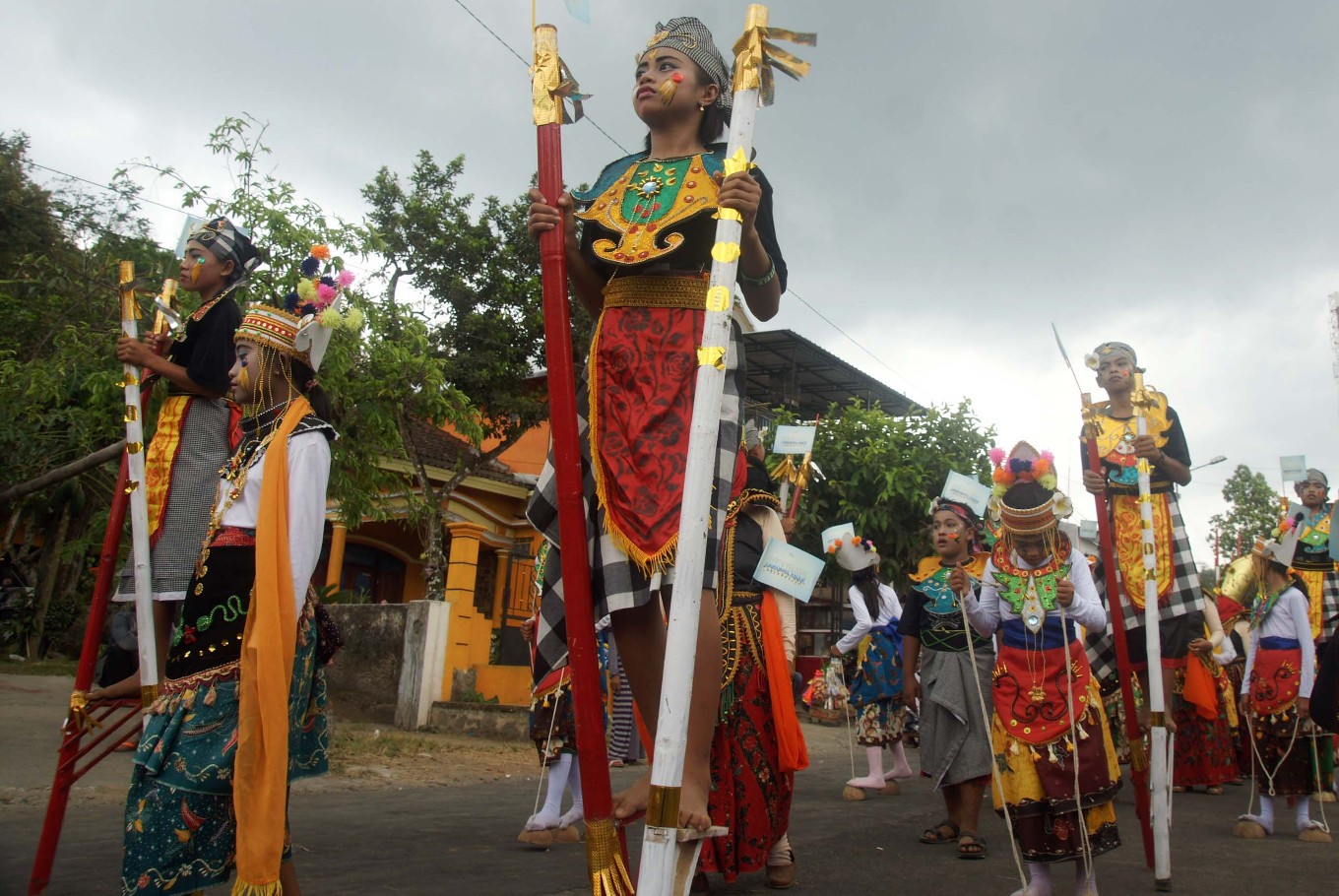Popular Reads
Top Results
Can't find what you're looking for?
View all search resultsPopular Reads
Top Results
Can't find what you're looking for?
View all search resultsSolving social problems of migrant workers’ children with ‘egrang’
The Tanoker Community held the eighth Sewindu Egrang Festival in Wates village, Ledokombo district, Jember regency on Saturday, Sept. 23. The community believes that egrang is a tool that encourages children, who are mostly from migrant workers' family, to move and change.
Change text size
Gift Premium Articles
to Anyone
I
rma, a fifth-grade student of state elementary school SD Lembengan 02, eagerly took a pair of egrang (bamboo stilts) and quickly stepped on to their footrests. Now she was several centimeters higher than the ground as she stood upright.
Alongside her 10 teammates, Irma danced to a song from a mini sound system. “I took around a week to learn to stand on egrang,” Irma told The Jakarta Post. “The preparation for this competition was about a month.”
The children were among 700 participants in the eighth annual Sewindu Egrang Festival, which was staged by the Tanoker (cocoon in Madurese language) Community, in Wates village, Ledokombo district, Jember regency, East Java, on Saturday, Sept. 23.
Twenty-four teams from seven villages in Ledokombo district performed on their bamboo stilts. There was also a parade that combined egrang with percussion and choreography, resulting in a dance entitled Tarian Egrang (Egrang Dance). Each of the participants had to decorate their egrang as attractively as possible, while at the same time they were required to wear traditional costumes from different provinces in Indonesia. On average, they spent Rp 500,000 ($37) to Rp 3 million on the decorations.
In several points of their 700-meter parade, they had to stop and perform their own dance moves in front of the judges in order to win prizes, which included cash amounts starting from Rp 1 million and a grand prize of two pregnant does.
“Actually egrang does not have any direct correlation with the purpose of Tanoker Community,” said Firha Ciciek, one of the initiators of the community, which was established in 2009. “Egrang is only a symbol or medium – a social-changing tool. It is something traditional that had fallen into disuse, but now is used to encourage children to move and change.”
The festival was held over four days from Sept. 20 - 23, and consisted of several events. Among them were the Refleksi Pengasuhan Anak Berbasis Komunitas (Reflection of Community-based Parenting) event, Jambore Anak (Children’s Camp) from six provinces and Lomba Pawai Egrang (Egrang Parade Competition).
Read also: Essay: The Colombo Plan in Madura Kalianget's wonderful outdoor cinema
Ciciek stated that the Tanoker Community mainly wanted to encourage people to become parents for all children near them, especially by using collaborative parenting, which is achieved through a social-cultural approach in a fun atmosphere.
At first, the spirit came from the problems in Ledokombo district, which Ciciek saw as a migrant-worker village. Aside from becoming small-scale sellers, factory workers, farmers and state or private employees, locals in general also work as migrant workers in Malaysia, Saudi Arabia, United Arab Emirates, Singapore, Hong Kong, Taiwan and Brunei Darussalam.
This situation has generated many problems in relation to their children’s quality of life. In most cases, they are abandoned as they are not raised with proper parenting. This leads them to drop out of their school, get involved in violence (physical, psychological, sexual) toward other children, and unwanted pregnancies. They also do not receive the civic documents they are entitled to.
Based on these issues, the Tanoker Community has gathered these children and collaborated with many parties to solve the problems. “Playing is learning for a better living. That’s what we came up with. Egrang is used as the medium because it’s one of the traditional games and the stilts are made from materials that can be found easily around Ledokombo,” said Ciciek, adding that they had built five community shelters in four villages with 500 children.
Meanwhile, Women’s Empowerment and Child Protection Minister Yohana Susana Yembise, said that the Tanoker Community’s program really helped the government. “It can answer the problems that occur in villages where Indonesian migrant workers live,” Yohana said during her visit to the festival, while promising that the government would collaborate with the community’s initiative.
Similarly, Faida, the Jember regent, also appreciated the community’s efforts in consistently conducting the festival eight years in a row. “I will include this festival as one of the annual events in Jember,” Faida said. “I’m proud [of it] because Ledokombo has become known both nationally and worldwide. The regency administration of Jember will fully support [the event] in the future, it’s because it’s good for children’s and women's interests.” (wir/asw)











